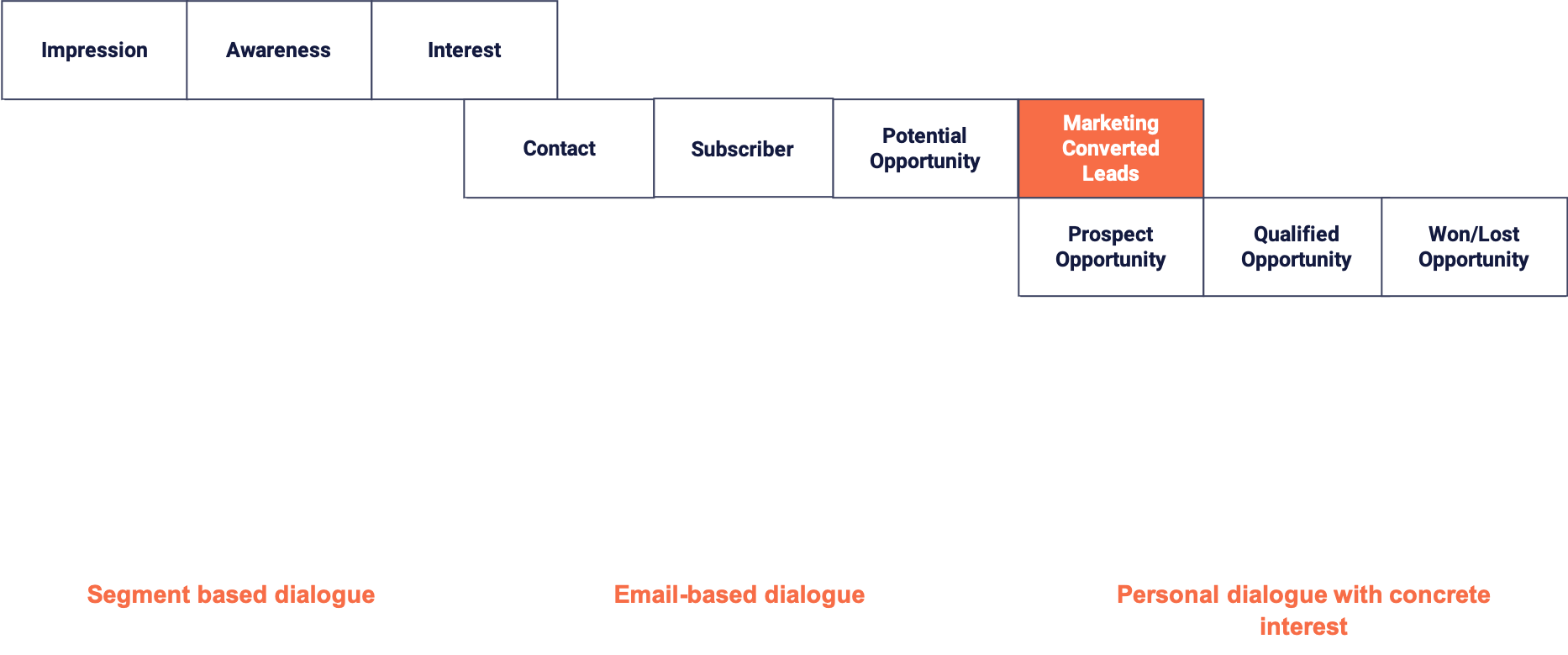I was part of a digital taskforce to help the collaboration between our Marketing and B2B Sales departments – especially regarding the handing over of Marketing Qualified Leads to the Sales department. We quickly discovered that the reason the main issues occurred was simply because of miscommunication and uncertainty about when the leads were in what stages and who had the responsibility.
For this reason, I developed a new model that clearly divided the leads into stages along the marketing and sales funnel. It added the entire division of steps for our marketing funnel, which before that weren’t clearly defined. This was a very important for us internally in the department, as the definition of our marketing efforts into concrete steps helped us display the value added in our effort before the leads reached the point of Marketing Qualified Leads.

The model is used for our paid campaigns only, meaning that all people and companies targeted would meet the criteria defined for our target group. As lead enter the model, they assigned to one of our stages depending on their actions and required dialogue type and they may jump several stages at once if their actions determine it. The lead source could be either network, partners, digital campaigns, events, etc. and they can be both new and existing pipeline.

The awareness stage is divided into a series a step related to our activities aiming at building brand awareness and interaction with our content to determine if they have a genuine interest. At this stage, all data is still anonymised and based entirely on the actions of people in a segment rather than individually identifiable users.
As we moved our B2B marketing more towards an account-based focus, I implemented a tool enabling us to link the user interaction data to specific companies through IP-matching, so that we are able to monitor the specific companies whose employees perform these interactions on our owned platforms.
Not only did this help us making the “intangible” awareness-stage very concrete in terms on measuring, it has also greatly improved our insights into the potential leads that are relevant for our account-based marketing efforts.
Another nice side-effect of this setup was that the new availability of data was a huge improvement transparency-wise and “now we can actually see who is on our websites and what services and industris they’re looking at”. For at sales person, this is a great help, as they now know exactly where to start the conversasion with the lead – and also, from a personal perspective, transparency in general is just a very good idea when trying to digitally transform more traditional sales departments.

The contact stage focused on tracking the contact’s behaviour on our various websites and email flows drive them through the customer journey and convert them to leads for our sales department as “Marketing Converted Leads” – MQLs with a minor modification as not to confuse them with our “Qualified Opportunities”.
The various steps are described above as determined by a series of interactions, though as we gradually improved our contact data, I developed a more sophisticated lead scoring system as well as an AI powered predictive lead scoring system that enabled us to predict the likelyhood of converting a contact into a lead from very early stages.
This setup I futher developed with an Account-based version to run alongside our Contact sales stage framework. This system uses Contacts’ behaviour and characteristica to score all incoming companies on relevance and activity on our platforms. In this way we are able to identify the most relevant companies to target in our account based marketing to increase our impact on their decision-making process.

As this is very much our sales department’s area in the way they work with our foreign direct investment leads – called “Opportunities” – my role in this as a digital marketeer is to make sure all automated dialogue in no way interferes with the personal sales dialogue between the customer and our sales consultants.
Still, we work with rather big investment cases and normally, the fDi decision process is rather complex, so one way that I still come into the picture is if we are to make a special effort to influence different areas of the specific account through digital channels or perhaps to use them to get access to higher level of decision-maker in the company.
An then of course, as we sometimes work with sales processes that can take several years, to keep our sales consultants constantly up-to-date with all activity from their Opportunities, so they’ll always know exactly which news, cases or industry insights their current leads are looking at.